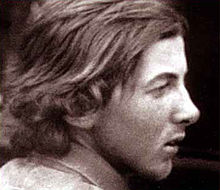Henry Cowell
Henry Dixon Cowell (born March 11, 1897 in Menlo Park , California , † December 10, 1965 in Shady , New York ) was an American composer
Life
Having come into contact with non-European music at an early age, the Irish-born Cowell trained primarily as a self-taught pianist and composer. From 1914 he studied at the University of California with Charles Seeger . In the 1920s he made annual tours through North America and Europe, where he was introduced to the young pianist Grete Sultan by Richard Buhlig in Berlin in 1923 ; an intensive collaboration began. In 1929 he was the first American composer to visit the Soviet Union . In 1931 he completed his training by studying comparative musicology in Berlin with Erich von Hornbostel , and in the same year he also gave a concert at the Bauhaus in Dessau . On a study trip through Asia, he taught at the music academies in Tehran and Madras . He was then a professor at Columbia University in New York City . His students included John Cage and Lou Harrison . Cowell also served as a publicist and editor of the New Music Edition , a platform for new American music.
Cowell was incarcerated in San Quentin State Prison from 1936 to 1940 for homosexual acts . He continued to compose while in prison. In 1940 he was released into the care of the composer and pianist Percy Grainger and pardoned in 1942.
Cowell experimented with clusters early on and developed the technique of the string piano , whereby the strings of the piano are directly plucked, wiped, scraped or scratched, thus paving the way for the prepared piano by John Cage. The artistic development of Grete Sultan was also decisively shaped by Cowell. Together with Joseph Schillinger, he designed the Rhythmicon , which was built in 1931 by the Russian Leon Theremin and made it possible to automatically generate rhythms. Together with Charles Ives , Charles Ruggles , John J. Becker and Wallingford Riegger , he is counted among the avant-garde composers group of the American Five .
Cowell composed 19 mainly programmatic symphonies and other symphonic works, including two concertos for koto , one for percussion and an accordion concerto , a suite for piano and chamber orchestra, numerous chamber music works, choirs and songs . He has also published essays on music theory . From 1927 to 1936 he published the New Music Quarterly magazine.
In 1951 he was elected to the American Academy of Arts and Letters . Cowell was married to the ethnographer and anthropologist Sidney Robertson Cowell from 1941 until his death in 1965 .
Works (selection)
- The Tides of Manaunaun , 1912
- The Lilt of Reel , 1925
- Piano Concerto , 1930
- Synchrony , 1931
- Gaelic Symphony , 1942
- Persian Set for 12 instruments , 1957
- Concerto for Koto and Orchestra , 1964
- Advertisement
- tiger
- The Aeolian Harp, 1923
- The Banshee, 1925
- Mosaic Quartet
Fonts
-
New Musical Resources , 1919
- New edition 1996, Cambridge University Press, ISBN 978-0521499743
- American Composers on American Music (Ed.), 1933
literature
- Moritz von Bredow: rebellious pianist. The life of Grete Sultan between Berlin and New York. Schott Music, Mainz 2012, ISBN 978-3-7957-0800-9 (biography of the pianist with many references to Henry Cowell and Berlin's musical life. With a never before published photograph of Henry Cowell from 1923 with Richard Buhlig and Wesley Kuhnle!).
- Joel Sachs: Henry Cowell - a man made of music. Oxford University Press, Oxford 2012, ISBN 978-0-19-510895-8 .
- David Nicholls (Ed.): The Whole World of Music . A Henry Cowell Symposium (= Contemporary Music Studies . Volume 16 ). Harwood Academic, Amsterdam 1998, ISBN 90-5755-004-0 .
Web links
- Henry Cowell website with biography, discography and catalog raisonné
Individual evidence
- ↑ Encyclopædia Britannica, accessed February 9, 2020
- ^ Members: Henry Cowell. American Academy of Arts and Letters, accessed February 24, 2019 .
| personal data | |
|---|---|
| SURNAME | Cowell, Henry |
| ALTERNATIVE NAMES | Cowell, Henry Dixon (full name) |
| BRIEF DESCRIPTION | American composer |
| DATE OF BIRTH | March 11, 1897 |
| PLACE OF BIRTH | Menlo Park , California |
| DATE OF DEATH | December 10, 1965 |
| Place of death | Shady , New York (State) |


